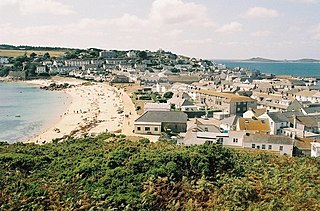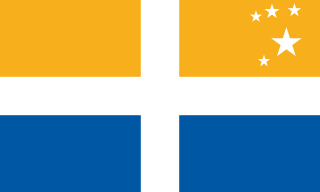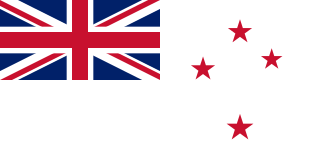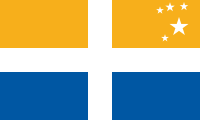
The national flag of the Netherlands is a horizontal tricolour of red, white, and blue. The current design originates as a variant of the late 16th century orange-white-blue Prinsenvlag, evolving in the early 17th century as the red-white-blue Statenvlag, the naval flag of the States-General of the Dutch Republic, making the Dutch flag the oldest tricolour flag in continuous use. As a flag that symbolises the transformation from monarchy to republic, it has inspired both the derivative Russian flag, and after the French Revolution in 1789, the vertically striped French tricolour; both flags in turn influenced many other tricolours. During the economic crisis of the 1930s, the old Prince's Flag with the colour orange gained some popularity among some people. To end the confusion, the colours red, white and blue and its official status as the national flag of the Kingdom of the Netherlands were reaffirmed by royal decree on 19 February 1937.

The Union Jack or Union Flag is the de facto national flag of the United Kingdom. The Union Jack was also used as the official flag of several British colonies and dominions before they adopted their own national flags. The flag continues to have official status in Canada, by parliamentary resolution, where it is known as the Royal Union Flag. However, it is commonly referred to in Canada as the Union Jack.

The flag of New Zealand, also known as the New Zealand Ensign, is based on the British maritime Blue Ensign – a blue field with the Union Jack in the canton or upper hoist corner – augmented or defaced with four red stars centred within four white stars, representing the Southern Cross constellation.

Hugh Town is the largest settlement on the Isles of Scilly and its administrative centre. The town is situated on the island of St Mary's, the largest and most populous island in the archipelago, and is located on a narrow isthmus which joins the peninsula known as the Garrison with the rest of the island.

The flag of Solomon Islands consists of a thin yellow diagonal stripe from the lower hoist-side corner, with a blue upper triangle and green lower triangle, and the canton charged with five white stars. Adopted in 1977 to replace the British Blue Ensign defaced with the arms of the protectorate, it has been the flag of Solomon Islands since 18 November of that year, eight months before the country gained independence. Although the number of provinces has since increased, the number of stars on the flag that originally represented them remained unchanged.

The White Ensign, at one time called the St George's Ensign because of the simultaneous existence of a crossless version of the flag, is an ensign worn on British Royal Navy ships and shore establishments. It consists of a red St George's Cross on a white field, identical to the flag of England except with the Union Flag in the upper canton.

The lesser white-toothed shrew is a small species of shrew with a widespread distribution in Africa, Asia and Europe. Its preferred habitat is scrub and gardens and it feeds on insects, arachnids, worms, gastropods, newts and small rodents, though its diet usually varies according to the biotope where it lives. The closely related Asian lesser white-toothed shrew was once included in this species, but is now considered to be a separate species.

The Isles of Scilly Steamship Company (ISSC) operates the principal shipping service from Penzance, in Cornwall, to the Isles of Scilly, located 28 miles (45 km) to the southwest. It provides a year-round cargo service together with a seasonal passenger service in summer. The name of the company's principal ferry, the Scillonian III, is perhaps better known than that of the company itself.

Gugh could be described as the sixth inhabited island of the Isles of Scilly, but is usually included with St Agnes with which it is joined by a sandy tombolo known as "The Bar" when exposed at low tide. The island is only about 1 km (0.62 mi) long and about 0.5 km (0.31 mi) wide, with the highest point, Kittern Hill at 34 m (112 ft). The geology consists of Hercynian granite with shallow podzolic soils on the higher ground and deeper sandy soils on the lower ground. The former Gugh farm is just north of the neck across the middle of the island between the two hills. The two houses were designed and built in the 1920s by Charles Hamlet Cooper.

The national flag of Australia is based on the British Blue Ensign—a blue field with the Union Jack in the upper hoist quarter—augmented with a large white seven-pointed star and a representation of the Southern Cross constellation, made up of five white stars. Australia also has a number of other official flags representing its people and government bodies.

St Mary's Airport or Isles of Scilly Airport is an airport located 1 nautical mile east of Hugh Town on St Mary's in the Isles of Scilly, to the south west of Cornwall, UK. It is the only fixed-wing airport serving the Isles of Scilly, handling most air traffic to and from the Islands. The airport is owned by the Duchy of Cornwall and currently is operated by the Council of the Isles of Scilly.

RMV Scillonian III is a passenger ship based at Penzance in Cornwall, England, United Kingdom, run by the Isles of Scilly Steamship Company. She operates the principal ferry service to the Isles of Scilly and is one of only three ships in the world still carrying the status of Royal Mail Ship.
RMV Scillonian was a passenger ferry built for the Isles of Scilly Steamship Company in 1925 by the Ailsa Shipbuilding Company Ltd of Troon, Scotland. She was designed to carry 400 passengers and cargo between Penzance, Cornwall, UK, to the offshore Isles of Scilly.

The Isles of Scilly are a small archipelago off the southwestern tip of Cornwall, England, United Kingdom. One of the islands, St Agnes, is over four miles further south than the most southerly point of the British mainland at Lizard Point.

Many different symbols are associated with Cornwall, a region which has disputed constitutional status within the United Kingdom . Saint Piran's Flag, a white cross on a black background is often seen in Cornwall. The Duchy of Cornwall shield of 15 gold bezants on a black field is also used. Because of these two symbols black, white and gold are considered colours symbolic of Cornwall.
Scillonian was a passenger ferry built for the Isles of Scilly Steamship Company in 1955 by John I. Thornycroft & Company of Woolston, Southampton. She was designed to carry 500 passengers and cargo between Penzance, Cornwall, to the offshore Isles of Scilly.
Queen of the Isles was a passenger ferry built for the Isles of Scilly Steamship Company in 1964 by Charles Hill & Sons. She was designed to carry passengers and cargo between Penzance, Cornwall, UK, to the offshore Isles of Scilly, complementing the service provided by the other company ship Scillonian. After running her for the service between Penzance and Scilly from 1964 to 1966, the Isles of Scilly Steamship Company put Queen of the Isles on a range of brief charters, including with P & A Campbell, before selling her in 1970.
Tregarthen's Hotel is a hotel in Hugh Town on St Mary's in the Isles of Scilly.
The Isles of Scilly are an archipelago 45 km (28 mi) off Land's End, Cornwall. Little of the fauna on, above or in the seas surrounding the isles was described prior to the 19th century, when birds and fish started to be described. Most records of other animals date from the 20th century onwards.

The New Zealand White Ensign is a naval ensign used by ships of the Royal New Zealand Navy (RNZN) from 1968. Based on the Royal Navy's White Ensign, it features the Southern Cross from the New Zealand national flag in place of the Saint George's Cross. One of the earliest flags associated with the country, that used by the United Tribes of New Zealand, was a white ensign. This was replaced by the Union Flag when New Zealand became a British colony. A blue ensign with the Southern Cross was introduced for ships of the colonial government in 1867 and this soon became a de facto national flag. Ships in New Zealand naval service wore the Royal Navy's White Ensign until 1968 when the distinct New Zealand White Ensign was introduced. The ensign was implemented out of a desire to distinguish New Zealand vessels from those of the Royal Navy and this decision is regarded as an important step in the development of the RNZN.



























